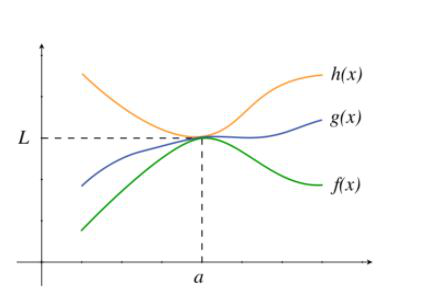我们知道有六个三角函数。考虑到函数的域和范围,可以根据函数的连续性来计算每个函数趋于某一点的极限。我们可以在每个函数的图中观察到,每个函数在同一点的限制是不同的。
正弦函数
函数f(x)= sin(x)是在其整个域上的连续函数,其域由所有实数组成。如下图所示,此函数的范围是[-1,1]:

因此,如果正弦函数的极限是在任何给定的实数下计算的,则它总是被定义并且位于[-1,1]之间。
f(x) = sin(x)
limx→a f(x) = limx→a sin(x)
= sin(a), where a is a real number
例1:求出lim x→π/ 2 sin(x)
解决方案:
As we know sin(x) is defined at π/2
Therefore,
limx→π/2 sin(x) = sin(π/2) = 1
示例2:找到lim x→πsin (x)
解决方案:
As we know sin(x) is defined at π
Therefore,
limx→π sin(x) = sin(π) = 0
余弦函数
函数f(x)= cos(x)是在其整个域上的连续函数,其域由所有实数组成。
如下图所示,此函数的范围是[-1,1]:

因此,如果余弦函数的极限是在任何给定的实数下计算的,则它总是被定义并且位于[-1,1]之间。
f(x) = cos(x)
limx→a f(x) = limx→a cos(x)
= cos(a), where a is a real number
例1:求出lim x→π/ 2 cos(x)
解决方案:
As we know cos(x) is continuous and defined at π/2
Therefore,
limx→π/2 cos(x) = cos(π/2) = 0
示例2:找到lim x→π cos(x)
解决方案:
As we know cos(x) is continuous and defined at π
Therefore,
limx→π cos(x) = cos(π) = -1
切线函数
函数f(x)= tan(x)在所有实数上定义,除了cos(x)等于0的值,即所有整数n的值π/ 2 +πn。因此,它的域是除π/ 2 +πn,n€Z之外的所有实数。
该函数的范围是(-∞,+ c)。

因此,如果切线函数的极限是在其范围内计算的,则它总是被定义并且位于(-∞,+∞)之间。
f(x) = tan(x)
limx→a f(x) = limx→a tan(x)
= tan(a), where a belongs to real no. except π/2 + πn, n € Z
例1:求出lim x→π/ 2 tan(x)
解决方案:
As we can see in graph tan(x) is tending to +∞ as x→-π/2 and to -∞ as x→+π/2
So, the right hand and left-hand limits of this function at π/2 are not same
Therefore,
limx→π/2 tan(x) = Not defined
示例2:找到lim x→ πtan(x)
解决方案:
As we know tan(x) is continuous and defined at π
Therefore,
limx→π tan(x) = tan(π) = 0
Cosec函数
函数f(x)= cosec(x)是在所有实数上定义的,但sin(x)等于0的值即所有整数n的值πn除外。因此,它的域是除πn,n€Z之外的所有实数。
此函数的范围是(-∞,-1] U [1,+∞)。
因此,如果余弦函数的极限是在其范围内计算的,则它总是被定义并且位于其范围之间。
f(x) = cosec(x)
limx→a f(x) = limx→a cosec(x)
= cosec(a), where a belongs to real no. except for πn , n € Z
示例1:找到lim x→ π cosec(x)
解决方案:
As we know sin(x) is 0 as x→π
So, 1/sin(x) i.e. cosec(x) at π cannot be defined
Therefore,
limx→π cosec(x) = Not defined
示例2:找到lim x→ π / 2 cosec(x)
解决方案:
As we know tan(x) is continuous and defined at π/2
Therefore,
limx→π/2 cosec(x) = cosec(π/2) = 1
正割函数
函数f(x)= sec(x)在所有实数上定义,除了cos(x)等于0的值,即所有整数n的值π/ 2 +πn。因此,它的域是除π/ 2 +πn,n€Z之外的所有实数。
该函数的范围是(-∞,-1] U [1,+∞)
因此,如果秒函数的极限是在其域中计算的,则它总是被定义并且位于其范围之间。
f(x) = sec(x)
limx→a f(x) = limx→a sec(x)
= sec(a), where a belongs to real no. except for π/2 + πn, n € Z
示例1:找到lim x→ π / 2 sec(x)
解决方案:
As we know cos(x) is 0 as x→π/2
So, 1/cos(x) i.e. sec(x) at π/2 cannot be defined
Therefore,
limx→π/2 sec(x) = Not defined
示例2:找到lim x→ πsec (x)
解决方案:
As we know tan(x) is continuous and defined at π
Therefore,
limx→π cosec(x) = sec(π) = -1
婴儿床函数
函数f(x)= cot(x)是在所有实数上定义的,但tan(x)等于0的值(即,所有整数n的值πn)除外。因此,它的域是除πn,n€Z之外的所有实数。
该函数的范围是(-∞,+∞)
因此,如果cot函数的极限是在其范围内计算的,则它总是被定义并且位于其范围之间。
f(x) = cot(x)
limx→a f(x) = limx→a cot(x)
= cot(a), where a belongs to real no. except for πn, n € Z
示例1:找到lim x→ πcot(x)
解决方案:
As we know tan(x) is 0 as x→π
So, 1/tan(x) i.e. cot(x) at π cannot be defined
Therefore,
limx→π cot(x) = Not defined
示例2:找到lim x→π/ 2 cot(x)
解决方案:
As we know cot(x) is continuous and defined at π/2
Therefore,
limx→π/2 cot(x) = cot(π/2) = 0
夹心定理(挤压定理)
该定理用于计算那些不能轻易计算极限的函数的极限(例如x = 0时的sin x / x)。
函数g(x)被压缩或夹在两个函数h(x)和g(x)之间,使得f (x)≤g(x)≤h(x ) 。
在这种情况下的图形如下所示:

我们可以说h(x)是g(x)的上限,f(x)是在点a处的下限,如上图所示:
if,
limx→a h(x) = L and limx→a f(x) = L,
where a is the point at which limit is being calculated and L is the value of the limit
Then,
limx→a g(x) = L
范例1:假设:g(x)= x2sin(1 / x),求出:lim x→0 g(x)
解决方案:
We know,
-1≤ sin(1/x) ≤ 1 under its domain
Multiplying with x2,
-x2 ≤ x2sin(1/x) ≤ x2
Then let f(x) = -x2 and h(x) = x2
f(x) ≤ g(x) ≤ h(x)
Using sandwich theorem,
As limx→a h(x) = limx→a f(x) = L
Therefore,
limx→a g(x) = L
limx→0 f(x) = limx→0 -x2 = 0 and
limx→0 h(x) = limx→0 x2 = 0
Therefore,
limx→0 g(x) = 0
例2:给定:g(x)= cos(x)/ x,求出:lim x→∞g (x)
解决方案:
We know,
-1≤ cos(x)≤ 1 under its domain
Dividing by x,
-1/x ≤ cos(x)/x ≤ 1/x
Then let f(x) = -1/x and h(x) = 1/x
f(x) ≤ g(x) ≤ h(x)
Using sandwich theorem,
As limx→a h(x) = limx→a f(x) = L
Therefore,
limx→a g(x) = L
limx→∞ f(x) = limx→∞ -1/x = 0 and
limx→∞ h(x) = limx→∞ 1/x = 0
Therefore,
limx→∞ g(x) = 0